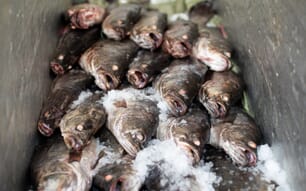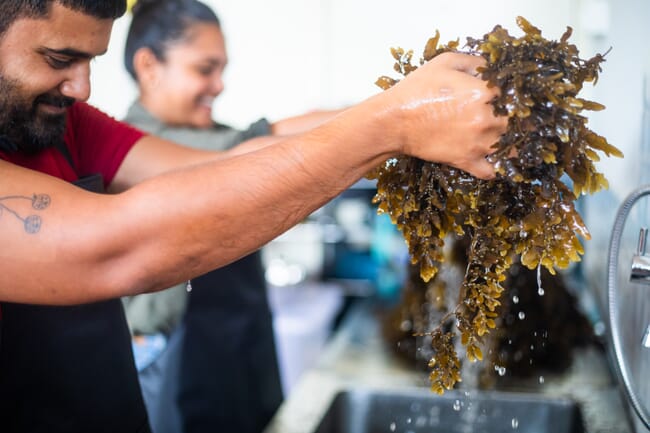
Head of operations and founder of The Good Ocean © Rebecca D'Costa
Many Goan locals can’t understand why Gabriella D’Cruz – an Oxford-educated Indian who speaks impeccable English – could elect to spend long days free-diving for seaweed, but it’s part of the appeal for her, as she attempts to breathe new life into the country’s seaweed sector.
“People think I’m strange because I eat seaweed and the fact that I harvest the seaweed myself is seen as a very strange thing, but one of the reasons I started this company is the chance to be in the sea and to harvest – it’s one of the most exciting parts of the job,” she reflects.
Following a masters in biodiversity conservation and management at the University of Oxford D’Cruz’s interest in India’s seaweed sector was really sparked by a visit to a community of women seaweed harvesters in the Gulf of Mannar, in Tamil Nadu.
“I was really interested because there are not a lot of women that lead fisheries industries in India. Usually they are only involved in processing, but here there was a business run by women on their own – taking the boats out, harvesting the seaweed. I thought that was really impressive,” she reflects.
However, as the harvesters explained to D’Cruz, while many people – including journalists and researchers – were taking an interest in their work, few were prepared to work with them to help improve the prices they were getting for their produce, nor to join them in a bid to strengthen the sector.
“There’s always a risk of going to communities, learning from them, romanticising them, but not really intervening in that supply chain. So I really thought that, if I wanted to be part of that industry, I first had to see if it was financially viable for myself, which is why I started up my own company,” D’Cruz explains.
From Scotland to Goa
Having finished her masters in England she was then given an opportunity to work with Mara Seaweed – one of Scotland’s first seaweed-for-food companies – before deciding to try something similar back home.
“I initially wanted to work with the women in Tamil Nadu but, because of Covid, I decided to base my company in Goa, which is where I’m from,” she explains.
Given the location, and her background in conservation – she’d worked for WWF India prior to her masters – D’Cruz decided that she would move away from the more industrial model that currently dominates the country’s seaweed sector and concentrate on harvesting low volumes of seaweed for higher value applications.
“I wanted to start a business that was low extraction, high value, so food really made sense,” she reflects.
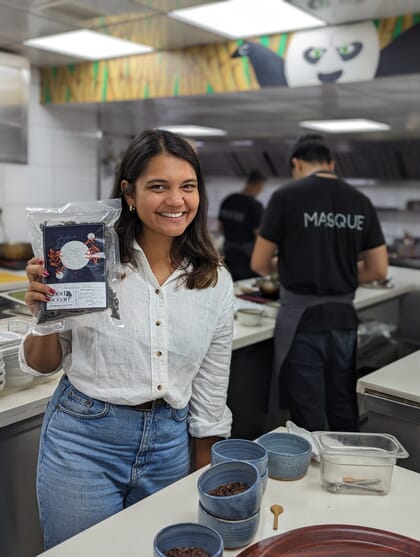
© Rebecca D'Costa
While the idea might have seemed logical to D’Cruz, it was harder to persuade the population of a country where there is no tradition of eating seaweed. However, high end restaurants from all over India were quick on the uptake once she began to market The Good Ocean's produce.
“Once we told people our story and introduced them to the diversity of seaweed off our coast, many chefs – who had long wanted to work with seaweed – started coming to us. And the last two seasons we have seen more demand than we’re able to supply,” she explains.
D’Cruz initially did all the harvesting herself, but has since hired Chaitanya Chowgule, who now heads operations, and a seasonal team of local harvesters and processors, who are paid by the kilo and hour respectively.
“We can’t hire them full-time at the moment, for example we can’t harvest during the Monsoon, but we’re hoping that once we set up more robust farming systems, possibly a land-based system, that we can hire people more full-time,” she explains.
The Good Ocean’s main crop is currently wild sargassum – which is both abundant and culinarily versatile. However, they are keen to find ways of farming other species, despite abandoning their original Gracilaria farming project a few years ago after issues with storms, salinity levels and disease.
This experience made D’Cruz decide to concentrate on building the market for seaweed, rather than cultivation. However, she is hoping that the gradual increase in research into cultivating species such as Gracilaria that is now taking place will help support a more diverse, and less Kappaphycus-dependent, seaweed sector.
“Transitioning from a wild-harvest to a farming system is what we need to really do well as a business and also to become replicable. As a small food company we don’t have a big impact, but if we scale to start producing for the petfood or nutraceutical industries we’d need to farm it,” she notes.
D’Cruz is encouraged by the positive, albeit gradual, steps that are being taken in this direction and she thinks there might be scope to work with some of the other key actors in this space.
“Now we’re seeing more people farming Gracilaria and we feel more capable of either working with them or partnering with a research organisation that can provide more data. The ideal goal would be to farm more native species on raft systems, longlines or land-based systems. But we want to do it in a way that – unlike in the shrimp industry where farmers usually work for wealthy landowners – the farmers would be the local fishing communities, who would own their own rafts. We can eventually partner with them,” she explains.
“I’d also like to see a better payment structure, as seaweed farming and harvesting communities get low pay. Our harvesters get six to ten times more by virtue of the fact that we can sell our seaweed at a higher price,” she adds.
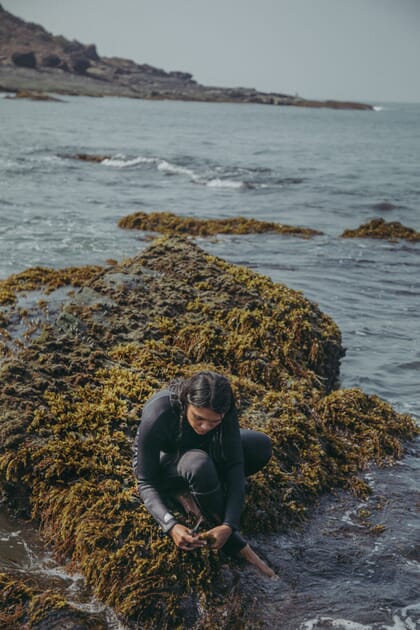
Harvesting is one of her favourite parts of the job © Rebecca D'Costa
Key milestones
D’Cruz sees being the first company in India to develop a way to process the seaweed in a food-grade manner and establishing strict harvesting guidelines as her two main achievements to date. She is also proud of – and believes she has learned from – her initial attempt to cultivate seaweed, despite having to mothball the plan.
“We thought we could do this on our own but we’re realised that we need a lot more institutional support and a lot more funding if we’re going to keep studying how to farm these native seaweeds,” she reflects.
She is also proud to have build up a team of harvesters who are now knowledgeable about, and invested in, the health of Goa’s seaweed forests.
In terms of challenges still to overcome, D’Cruz would like to see the development of farming technologies and the establishment of hatcheries – both of which she thinks should be supported by the local government. In the processing side she’d like to see the development of faster and more affordable technologies for drying and testing the harvested products. Meanwhile, she would like to see more baseline data on local species being collected so that the impacts of climate change on the seaweed forests can be scientifically assessed.
Now that The Good Ocean has developed its processing capacity and built up a substantial customer base who are prepared to eat their produce they would like to attract funding – perhaps through an innovation grant – to allow either themselves, or partner farmers, to improve production of a variety of seaweed species.
“Kappaphycus is generally what the government has been pushing, I think because there’s a biostimulant industry and a gel industry that’s willing to buy that seaweed. As a food company, we’re such a small player so we’re not a priority for research organisations. But we’re now seeing Gracilaria species, Ulva species and Caulerpa species being considered to help diversify the markets,” notes D’Cruz.
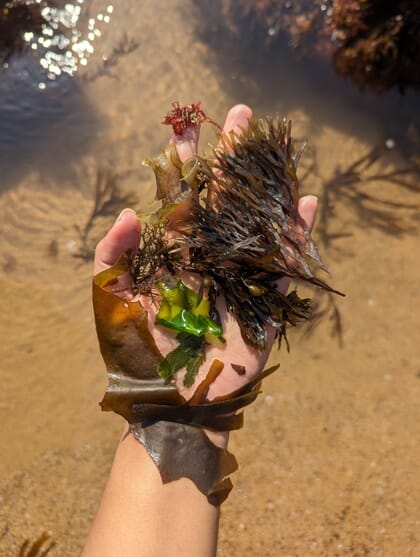
© Rebecca D'Costa
Prospects for the sector
D’Cruz is determined to stay in the sector for the long haul and, fittingly, has a long-term vision – both for her company and India’s seaweed sector as a whole.
“Coming back to the women in coastal Tamil Nadu, it would be great if our supply chain could in replicable: if a community in Tamil Nadu could process their own seaweed and sell it for significantly more. So creating new high value supply chains is really where I see the bigger picture,” she reflects.
And for The Good Ocean Itself?
In the shorter term D’Cruz is aiming to keep selling their own seaweed and increase their processing capacity – potentially through a network of decentralised processing units. But she would also like to see the benefits of the sector have an even wider reach.
“It would be good if we were an aggregator who could inform coastal communities about other market opportunities, get them to understand what processing equipment they would need to access these markets and either sell the seaweed for them, at a higher price, or enable them to set up their own supply chains,” she concludes.



